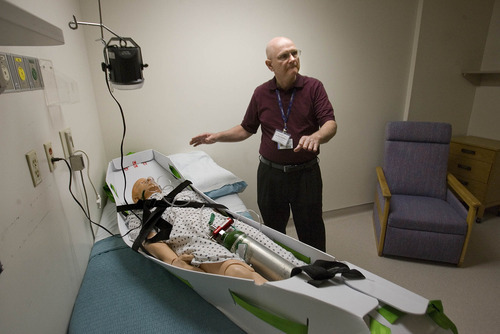This is an archived article that was published on sltrib.com in 2012, and information in the article may be outdated. It is provided only for personal research purposes and may not be reprinted.
With the opening of a new emergency preparedness center, Utah medical workers will now be able to not only train in real environments, but also use that space if disaster strikes.
The Intermountain Center for Disaster Preparedness officially opened Friday on the third floor of LDS Hospital. The 7,000-square-foot center is equipped with training classrooms, 17 patient rooms, disaster situation simulators and emergency supplies.
Ann Allen, the emergency preparedness manager with the Intermountain Health Care's Urban Central Region, said this center is different from other training areas available in the state because trainees experience the simulations in real hospital rooms and with real hospital equipment.
"It's a real patient room; it's not make-believe," Allen said. "There's not a falseness. We're teaching them in their work environment, which is important."
The training center will be used by different groups specializing in disaster responses, such as EMTs, nurses and physicians. Allen said they have been operating in LDS Hospital unofficially for the last year and were able to conduct about 50 trainings for 1,000 people, but Friday marked their official opening date.
To kick off the opening, the hospital held an educational symposium for hospital and disaster preparedness specialists. The daylong symposium featured local and national disaster preparedness speakers, with keynote speaker Dan Diamond, who founded the nation's first state-affiliated medical disaster response team. Diamond, who served as director of the Mass Casualty Triage Unit at the New Orleans Convention Center during the aftermath of Hurricane Katrina, told the audience stories of the types of people he encountered while serving in the cleanup of the hurricane and how some chose to be victims and helpless, while others chose to give up everything they had and help others.
He also emphasized planning and working in teams. He applauded the local efforts that led to the emergency preparedness center.
"You have some movers and shakers in the community," Diamond said. "They are diligent and hardworking. Those guys are making a difference."
Allen said the support team for the preparedness center hopes that the training can be used to help officials not only in a large disaster event, like an earthquake, but also in smaller situations, such as with a patient who has been exposed to radiation.
"It doesn't have to be something so catastrophic," she said. "This allows us to have an area to care for patients."
Twitter: @jm_miller









